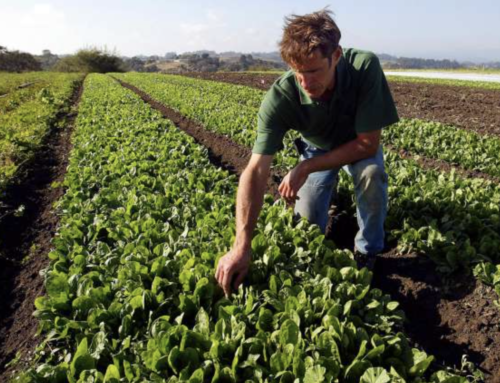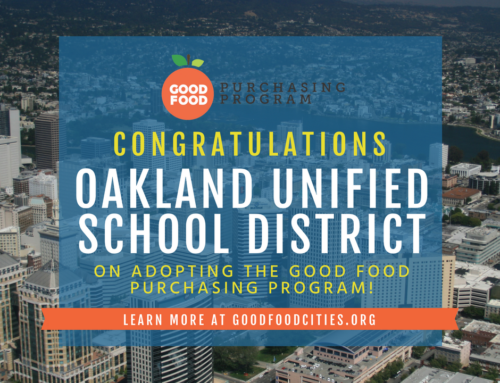How do you provide lunch for an entire city of hungry schoolchildren on a budget of just $1.25 a meal — and do so while also making sure the food is highly nutritious and sustainably sourced, and that it puts money back into the local economy?
That’s the kind of impossible puzzle that any large public school district faces. But the Oakland Unified School District’s food services program may soon have a new tool with the potential to make the task slightly more manageable. This week, the district’s school board will vote on whether to adopt the Good Food Purchasing Policy (GFPP), a set of purchasing standards that assigns participating school districts a “grade” based around five core values: nutrition, environmental sustainability, animal welfare, valued workforce (i.e., labor issues), and local economies.
OUSD would be the third school district to adopt the policy, joining the school districts of Los Angeles — where the Los Angeles Food Policy Council first created the program in 2012 — and San Francisco, which adopted the policy earlier this fall. The Center for Good Food Purchasing, a Berkeley-based nonprofit, administers the program. Its executive director Alexa Delwiche said that OUSD was a natural fit because the district already espouses many of the policy’s values.
During the tenure of nutrition services director Jennifer LeBarre, OUSD has been nationally recognized for its role as a leader in the so-called “farm to school” movement going as far back as 2010, and recently began incorporating organic beef into its $1.25-per-meal lunch budget. The district has also broken ground on its long-awaited West Oakland central kitchen, which, when it opens sometime during the 2017-18 school year, will allow the food services program to buy even more produce from local farms, and prep and cook a higher proportion of that food onsite.
The GFPP aims to give those values around sustainability and nutrition some teeth. In a nutshell, the Center for Good Food Purchasing collects and analyzes reams of paperwork from each participating school district to determine where every purchased ingredient came from — tracing it back to the name of an individual farm when possible. The Center then evaluates all of the data against the five criteria in its rubric, and assigns the district a star rating. In fact, even prior to officially adopting the policy, OUSD already went through this part of the process — twice, actually, in a kind of voluntary test run. The district received two stars, out of a possible five, for the 2012-13 school year, and went up to a three-star rating for 2014-15. Moving forward, the Center will work with OUSD to set short-term and long-term goals, and it will help hold the district accountable for reaching those benchmarks. The goal, after all, is to achieve that perfect five-star rating.
The school board is expected to vote in favor of adopting the GFPP at its October 26 meeting, though it wouldn’t be until after a later vote in March or April that the policy would officially get written into the district’s priorities.
“Measurement matters,” said Anna Lappé, a prominent Bay Area writer and sustainable food advocate who has been helping to promote the policy through her nonprofit, Real Food Media. “What you measure matters. If you’re just measuring the quantity of food served or the price, you’re not measuring what people care about.”
Part of the reason that Lappé and other food activists — from First Lady Michelle Obama on down — have placed so much emphasis on school food is because of the massive scale of these operations. OUSD, for instance, serves roughly 21,000 lunches each school day, plus a slightly smaller number of breakfasts, snacks, and suppers. There isn’t a restaurant in the city that operates on that kind of scale. It follows, then, that even relatively small changes to a district’s sourcing can wind up having a huge impact.
When the Los Angeles school district adopted the Good Food Purchasing Policy, it was preparing to negotiate a $60 million chicken contract with Tyson Foods, a multi-billion dollar company that has been fined for worker-safety violations. The upshot: After these concerns were raised, Tyson withdrew itself from consideration, and the district instead committed a large chunk of that money to buying antibiotic-free chicken through a different distributor. The district also went from purchasing just 9 percent of its food locally to 50–60 percent — a shift that put $12 million into the local economy and helped create about 150 jobs.
As Delwiche put it, “A small change for them is pretty dramatic.”
With both the San Francisco and Oakland school districts likely adopting the standards this year, and several other districts around the country interested in following suit, we are starting to see the makings of a larger movement — one that, in aggregate, has enough purchasing power to really shift the country’s overall food system.
One of the notable aspects of the Good Food Purchasing Policy is that it prioritizes labor issues, which often get overlooked within the broader food justice movement. For that reason, the Teamsters have thrown their support behind the policy. Doug Bloch, the political director for Teamsters Joint Council 7, which covers much of California, noted that the policy played an instrumental role in securing a contract for union delivery drivers in Los Angeles.
Bloch said he first saw the value of a concrete food purchasing policy a few years ago, when Oakland was buying much of its produce from Taylor Farms, whose Salinas site was touted as a model for farm-worker wages and benefits. Unfortunately, the farm’s other location in Tracy had been cited for dozens of worker-safety violations and launched what Bloch describes as the most brutal anti-union campaign he’d seen in 25 years of labor-organizing work. Long story short: The Teamsters lobbied the school board, and the district eventually severed its contract with Taylor Farms. But what if the union hadn’t made the effort? Or what if LeBarre were to leave, or less labor-friendly school board members got elected?
This isn’t just an abstract concern: In Los Angeles, for example, longtime nutrition services director David Binkle, who had advocated for the Good Food Purchasing Policy, resigned last year amid allegations of mismanagemed funds. In both Oakland and Los Angeles, the policy itself ensures that these core values — of sustainability, worker well-being, and so forth — remain locked in as district priorities, even as individual policymakers come and go. And it gives suppliers such as Taylor Farms a tangible reason to change their practices.
Otherwise, it’s incumbent on activists to raise these issues again and again, each time the district negotiates a new contract. Bloch hopes the Good Food Purchasing Policy will help take the politics out of that process: “Oakland is saying, ‘Our procurement policy is a reflection of our conscience as a district.'”





